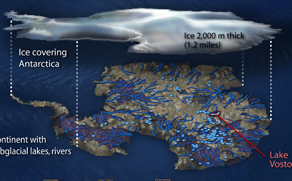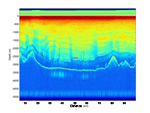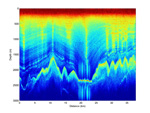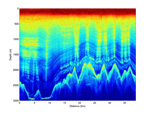Measuring Lakes
Now that you know what a subglacial lake looks like in a radar image you can start to explore under the ice. Let's see if you can calculate how 'big' the lakes are. There are many ways to talk about the size of a lake...some common ones are its length, its area and its volume. To calculate each of these we will need certain types of information. First let's determine what information we would need to calculate each item below, and then let's consider if we have what we need. What do we need to figure out the lake's:
Length_________
Area___________
Volume__________
How do these lakes 'size up'?
 Now let's see what information we have. For each image you have data from one air flight measuring one variable: depth along a single line, or crossing of the lake (click on the image to the left to enlarge). The 'X' axis of the image shows distance, or how far the plane has traveled along that line of the lake, and the 'Y' axis shows depth at the corresponding location. Using the data provided which of the calculations (length, area, volume) can you complete for the lakes?
Now let's see what information we have. For each image you have data from one air flight measuring one variable: depth along a single line, or crossing of the lake (click on the image to the left to enlarge). The 'X' axis of the image shows distance, or how far the plane has traveled along that line of the lake, and the 'Y' axis shows depth at the corresponding location. Using the data provided which of the calculations (length, area, volume) can you complete for the lakes?
Read through "Try the activity" and complete the excercises using the student worksheet below. Be careful! Note that not all the IMAGES use the same scale. Why would we chose different scales for the images?






